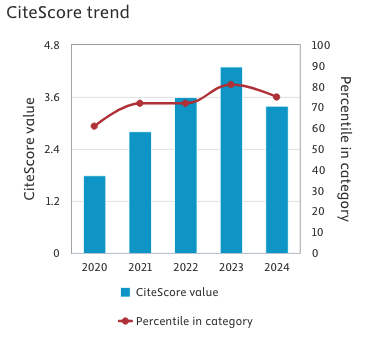Predictive value of valgus head-shaft angle in identifying Neer 4-part proximal humerus fractures. A radiographic and CT-scan analysis of 120 cases
Keywords:
Proximal humerus fractures, 4-part fracture, predictive value, Valgus displacement, Humeral head-shaft angleAbstract
Background and aim of the work: Understanding the fracture morphology and its relation to the expected
outcome and risk of complications is fundamental for proximal humerus fractures (PHFs) management.
Most Neer 3- and 4-part fractures may deserve surgical treatment. Unfortunately, plain x-rays may not be able
to differentiate between a 3- or 4-part fractures unless an axillary or analogue projection is carried out. Aim of
the present study is to evaluate whether a high valgus head-shaft angle degree is predictive of a Neer 4-part
rather than a 3-part fracture. Methods: The study included 120 3-(75 cases) and 4-(45 cases) part PHFs (valgus
displaced in 98 cases), M:F ratio = 1:2.6, mean age 65.7 years, classified on CT scan images. The humeral head
shaft angle was calculated on AP x-rays and statistically correlated with 3 and 4-part fractures to identify values
predictive of 4-part fracture. Results: Valgus head/shaft angle was significantly higher in 4-part fractures, especially in the valgus displaced group (p < 0.001). A cutoff value of 168.5° was identified as predictive of a 4-part fracture with a sensibility of 74% and specificity of 78%. Increasing by 1 degree the humeral head-shaft angle, the chance to have a 4-part fracture increases of 3% in the whole population and of 11% in the valgus sub-group.
Conclusion: The severity of PHF can be predicted analysing valgus head shaft angle on AP x-rays with a sensibility of 74% and specificity of 78% in identifying a 4-part fracture with a cutoff value of 168.5°.
References
Launonen AP, Lepola V, Saranko A, Flinkkila T, Laitinen M, Mattila VM. Epidemiology of proximal humerus fractures. Arch Osteoporos 2015;10(1):209
Court-Brown CM, Garg A, McQueen MM. The epidemiology of proximal humeral fractures. Acta Orthop Scand 2001;72(4):365–371
Hasty EK, Jernigan EW 3rd, Soo A, Varkey DT, Kamath GV. Trends in surgical management and costs for operative treatment of proximal Humerus fractures in the elderly. Orthopedics 2017;40:e641–7
Neer CS II. Displaced proximal humeral fractures. I. Classification and evaluation. J Bone Joint Surg Am 1970;52:1077-89
Iyengar JJ, Devcic Z, Sproul RC, Feeley BT. Nonoperative treatment of proximal humeral fractures. A systematic Review. J Orthop Trauma 2011;25:612–617
Court-Brown CM, Cattermole H, McQueen MM. Impacted valgus fractures (B1.1) of the proximal humerus. The results of non-operative treatment. J Bone Joint Surg Br 2002;84:504-8
Murray IR, Amin AK, White TO, Robinson CM. Proximal humeral fractures: current concepts in classification, treatment and outcomes. J Bone Joint Surg Br 2011;93:1–11.
Hertel R, Hemfing A, Stiehler M, Leunig M. Predictors of humeraL head ischemia after intracapsular fracture of the proximal humerus. J Shoulder Elbow Surg 2004;13:427–433
Shrader MW, Sanchez-Sotelo J, Sperling JW, Rowland CM, Cofield RH. Understanding proximal humerus fractures: image analysis, classification, and treatment. J Shoulder Elbow Surg 2005;14:497-505
Canbora MK, Kose O, Polat A, Konukoglu L, Gorgec M. Relationship between the functional outcomes and radiological results of conservatively treated displaced proximal humerus. Int J Shoulder Surg 2013;7(3):105–109.
Rose SH, Melton LJ, Morrey BF, Ilstrup DM, Riggs BL. Epidemiologic features of humeral fractures. Clin Orthop 1982;168:24–30
Vallier HA. Treatment of proximal humerus fractures. J Orthop Trauma 2007;21:469-76
Geusens E, Pans S, Verhulst D, Brys P. The modified axillary view of the shoulder, a painless alternative. Emerg Radiol 2006;12(5):227-230.
Berkes MB, Dines JS, Birnbaum JF, Lazaro LE, Lorich TC, Little MT, Nguyen JT, Lorich DG. The axillary view typically does not contribute to decision making in care for proximal humeral fractures. HSS J 2015;11(3):192e197
Jakob RP, Miniaci A, Anson PS, Jaberg H, Osterwalder A, Ganz R. Four-part valgus impacted fractures of the proximal humerus. J Bone Joint Surg Br 1991;73: 295-8
Handoll HHG, Ollivere BJ, Rollins KE. Interventions for treating proximal humeral fractures in adults. Cochrane Database Syst Rev 2012;12:CD000434
McLaurin TM. Proximal humerus fractures in the elderly are we operating on too many? Bull Hosp Jt Dis 2004;62:24-32
Jobin CM, Galdi B, Anakwenze OA, Ahmad CS, Levine WN. Reverse shoulder arthroplasty for the management of proximal humerus fractures. J Am Acad Orthop Surg 2015;23(3):190–201
Brorson S, Bagger J, Sylvest A, Hrobjartsson A. Diagnosing displaced four-part fractures of the proximal humerus: a review of observer studies. Int Orthop 2009;33:323–327
Robinson CM, Page RS. Severely impacted valgus proximal humeral fractures. Results of operative treatment. J Bone Joint Surg Am 2003;85:1647-55
Robinson CM, Longino D, Murray IR, Duckworth AD. Proximal humerus fractures with valgus deformity of the humeral head: the spectrum of injury, clinical assessment and treatment. J Should Elb Surg 2010;19:1105–1114
Catalano L, Dowling R. Valgus impacted fracture of the proximal humerus. J Hand Surg Am 2011;36(11):1843–1844
Dheenadhayalan J, Prasad VD, Devendra A, Rajasekaran S. Correlation of radiological parameters to functional outcome in complex proximal humerus fracture fixation: A study of 127 cases. J Orthop Surg 2019;27(2) 1–8
Iannotti JP, Lippitt SB, Williams GR. Variation in neck-shaft angle: influence in prosthetic design. Am J Orthop 2007;36:9-14
Poeze M, Lenssen AF, Van Empel JM, Verbruggen JP. Conservative management of proximal humeral fractures: Can poor functional outcome be related to standard transscapular radiographic evaluation? J Shoulder Elb Surg 2010;19:273-81
Downloads
Published
Issue
Section
License
This is an Open Access article distributed under the terms of the Creative Commons Attribution License (https://creativecommons.org/licenses/by-nc/4.0) which permits unrestricted use, distribution, and reproduction in any medium, provided the original work is properly cited.
Transfer of Copyright and Permission to Reproduce Parts of Published Papers.
Authors retain the copyright for their published work. No formal permission will be required to reproduce parts (tables or illustrations) of published papers, provided the source is quoted appropriately and reproduction has no commercial intent. Reproductions with commercial intent will require written permission and payment of royalties.







